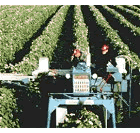Newsletter No. 27 - February 2001
NEWSLETTER NO. 27 - February 2001
The 2000 US Concord crop of 391,675 tons was 19% less than the record crop of 1999 and 8% less than the last 5 year average. Even though the 1999 crop was a record, there was only a modest carryover inventory going into the 2000 crop due to continued strong sales of bottled Concord juice. The total supply of Concord concentrate is now about average. However, California produced 1.1 million tons more grapes than in 1999, forcing extra grapes into the concentrate market. This has created very low prices for Red Grape concentrate, which competes with Concord. The price of White Grape concentrate is also extremely low. Some processors blend White Grape with Concord, to extend it's volume.
Prices paid growers for their Concord grapes dropped from 1999 by 3% in the East and 7% in Washington to $246 and $235/ton at 16° brix.
As of mid February, no winter freeze damage to the grape buds has occurred in any of the production areas. Current estimates are for an average to slightly below average crop for 2001. Many things can influence the crop size between now and next September/October when the grapes will be harvested.
Following is a brief report by Concord growing area:
New York, Pennsylvania and Ohio:
This area experienced a rather cool growing season. The crop was about 31% lighter than 1999's record yield per acre. Most of the vineyards had to take a rest from the stress placed on them by the big crop, as evidenced by a low number of berries per cluster. The quality of the juice has the normal acid level. It has been lower than average during the past two years. Researchers indicate the potential fruitfulness of the fruiting buds is less than average and are suggesting that growers leave up extra buds, as they prune, to compensate for it.
Michigan:
Vineyards produced high crop yields per acre; the 7th large crop in succession. Quantity and quality of the fruiting wood indicate at least an average crop prospect for 2001.
Washington:
Last spring, estimates were for a large crop, since it followed less than average crops for the last two years. That did not happen, primarily because of poor fruit set. The harvest amounted to 13% less than produced in 1999. This was the only production area which suffered some fall freeze damage losses. It was localized and amounted to less than 5% of the total tonnage. Prospects for the 2001 crop are now considered to be about average, at best.
Ontario:
Like New York, their crop was below average and 27% less than 1999.
Brazil:
The harvest of Concords and Isabellas was delayed by cool, rainy weather. Estimates for the size of the crop are said to be about average. Harvest is now underway.
Did you know?
Concord grapes are a 'specialty' crop, primarily because, to thrive, they require a cold winter climate and 180 day growing season. This eliminates California and Southern areas as well as far Northern areas. Of the 7.3 million tons of grapes produced in the US last year, only 6% were Concords. You can get our newsletters by e-mail (attached file from Microsoft Word), Click Here
These charts below will give you a brief overview of the United States Concordindustry for the past 5 years.
| U.S. Concord Production % of Total by Area - 2000  NY-PA-OH & WA produced about the same tonnage. Michigan increased its share of the total. |
U.S. Concord Supply Current Crop & Carryover 1996 - 2000  The total supply available from the 2000 crop, including carry over from the previous crop is well below last year but is only slightly less than the past 4 year average. |
| U.S. Concord Grape Prices Cash Buyers - Juice Industry 1996-2000  Prices paid growers by independent processors dropped very little from 99 due to low inventory and inflated pre-harvest estimates. |
Prices of 68° Brix Concord Concentrate at Start of Pack 1996-2000  Opening prices, December following harvest, are for single truckloads of drums. Prices have dropped since December due to stiff competition from the Red Grape market. |
|
Juices & Concentrates
|
U.S. Gal. or $
|
FOB or X-dock
|
|
| Apple | Single Strength | .63 - 1.05 | MI/WA/ONT/CA/NY |
| 70° Domestic | 4.55-5.50 | WA/CA | |
| 70° Imported | 4.50-5.00 | Most Ports | |
| Concord | Single Strength | 2.20 - 2.50 | MI/NY |
| 68° Domestic | 10.95-12.75 | WA/NY | |
| 68° Imported | Call us | Most ports | |
| Concord Type & Blends |
68° Domestic | 8.35-10.50 | WA/NJ |
| 68° Imported | Call us | Most ports | |
| Red Grape | 68° Domestic (200-1800 Color) |
6.80-8.50 | CA |
| 68° Imported (400-1000 Color) |
5.75-8.15 | Most ports | |
| White Grape | 68° Domestic | 4.25-4.75 | CA |
| 68° Imported | 4.40-4.90 | Most Ports | |
| 55-68° Niagara | 8.00-14.50 | WA | |
| Niagara Single Strength | 2.45 | MI | |
| Varietal Grape | Single Strength S.S. Catawba & Vidal |
Call us 2.50-2.75 |
NY/MI/CA/WA/ONT MI |
| Cranberry and Other Berry WONF |
50-65° | Call us | NW |
We also handle the following fruit and berry concentrates and purees:
| Acerola Apricot Banana Black Currant Black Raspberry Blackberry Blueberry Boysenberry Cantaloupe Cherry Cranberry |
Elderberry Grapefruit Guava Honeydew Kiwi Lemon Lime Loganberry Mango Orange Papaya |
Passionfruit Peach Pear Pineapple Plum Prune Red Currant Red Raspberry Strawberry Tomato Watermelon |
Grape & Fruit Essences
We have several sources of Concord and Niagara essences priced from $8.50 to $24.00 per gallon. We also can source essences of many of the fruits listed above; both standard and high fold.
PLEASE CALL US FOR FURTHER INFORMATION OR SAMPLES.


